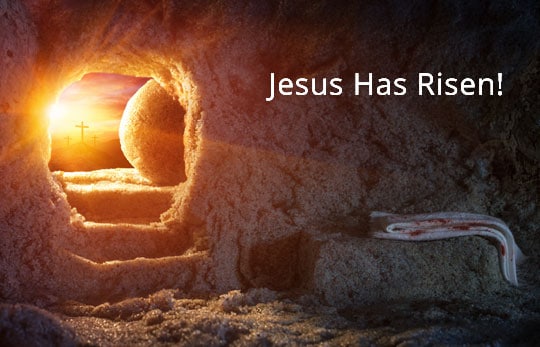Bible Question:
Was Jesus' face cloth in the tomb rolled up or folded?
Bible Answer:
If we compare the major Bible versions we discover that following Jesus’ resurrection, some versions state Jesus’ face or head cloth was rolled up and others say that it was folded. Therefore, the question that we are concerned with is which is correct? One passage that refers to the head cloth is John 20:7.
And so Simon Peter also came, following him, and entered the tomb; and he saw the linen wrappings lying there, and the face-cloth which had been on His head, not lying with the linen wrappings, but rolled up in a place by itself. John 20:6-7 (NASB)

Meaning of “Rolled Up”
The Greek word that is translated as “rolled up” in John 20:7 in the New American Standard is entylisso. The Greek word appears only three times in the New Testament. The first time the Greek word appears is in Matthew 27:59. In that verse it is translated as “wrapped.”
This man went to Pilate and asked for the body of Jesus. Then Pilate ordered it to be given to him.
59 And Joseph took the body and wrapped it in a clean linen cloth,
60 and laid it in his own new tomb, which he had hewn out in the rock; and he rolled a large stone against the entrance of the tomb and went away. Matthew 27:58-60 (NASB)
Verse 59 states that Joseph of Arimathea took Jesus’ body and wrapped the body using a linen cloth.
The second time entylisso appears in the New Testament is in Luke 23:53.
. . . a man from Arimathea, a city of the Jews, who was waiting for the kingdom of God;
52 this man went to Pilate and asked for the body of Jesus.
53 And he took it down and wrapped it in a linen cloth, and laid Him in a tomb cut into the rock, where no one had ever lain. Luke 23:51-53 (NASB)
In verse 53 the Greek word entylisso is translated as “wrapped” again. We have discovered that both Matthew 27:29 and Luke 23:53 use entylisso to refer Jesus’ body being wrapped.
According to a number of outstanding Greek lexicons, entylisso means “wrapped” and rarely does it mean “folded.” Liddell and Scott state that the Greek word entylisso is translated as “to wrap up” [1]. A. T. Robertson, the highly recognized Greek scholar, states that entylisso means “rolled up.”[2] Thayer’s Greek Lexicon defines entylisso as “to roll in” or “to wrap in.”[3] Danker and Bauer define the word as “to wrap something” or “to wrap around an object” for its use in the gospels.[4] It should be noted that Danker and Bauer cite one source where the word means “folded,” but they indicate that is not how the word was translated in both Matthew and Luke.
Meaning of John 20:7
Therefore, it is concluded that entylisso refers to the rolling up or wrapping of the head cloth in John 20:7.
And so Simon Peter also came, following him, and entered the tomb; and he saw the linen wrappings lying there, 7 and the face-cloth which had been on His head, not lying with the linen wrappings, but rolled up in a place by itself. John 20:6-7 (NASB)
But even if the head cloth was folded and not wrapped, the message of Matthew, Luke and John was the head cloth had been moved to a different location away from the rest of the linens. Additionally, the Greek word indicates that someone took time to either fold or roll it.
Conclusion:
If the disciples had stolen the body of Christ, they would have been in a hurry to remove the body and escape and would not have wanted to take the time to carefully fold or roll the head cloth. They would have tried to escape very quickly. The fact that the head cloth was moved and someone took time to roll or fold it speaks to the fact the disciples did not rob the body. B. F. Wescott writes,
There are no traces of haste. The deserted tomb bore the marks of perfect calm. The grave-clothes had been carefully removed, which would be a work of time and difficulty, and laid in two separate places. It was clear therefore that the body had not been stolen by enemies; it was scarcely less clear that it had been taken away by friends.[5]
One additional fact that is often overlooked is that the gospels reveal, especially the gospel of John, that the disciples did not believe Christ would be resurrected. Thomas doubted that Jesus was risen (John 20:24-29). The message of the gospels is that Christ is risen from the dead. Christ is risen!
References:
1. Liddell and Scott. Greek-English Lexcon. Oxford Press. 1996. p. 578.
2. Robertson, A. T. Word Pictures in the New Testament. Baker Book House. 1931. vol. v, p. 310.
3. Joseph Henry Thayer, A Greek-English Lexicon of the New Testament: Being Grimm’s Wilke’s Clavis Novi Testamenti. Christians Copyrights. 1983, 219
4. Danker and Bauer. Greek-Lexicon of the New Testament and Other Early Christian Literature. University Chicago Press. 1979. p. 341.
5. B. F. Wescott. The Gospel According to St. John. Eerdmans Publishing Co., 1975. p. 290.
Suggested Links:
Was God dead for three days? – After The CrucifixionDid Jesus’ body and spirit die?
Why did God let His son suffer and die?
Did Jesus descend into hell?